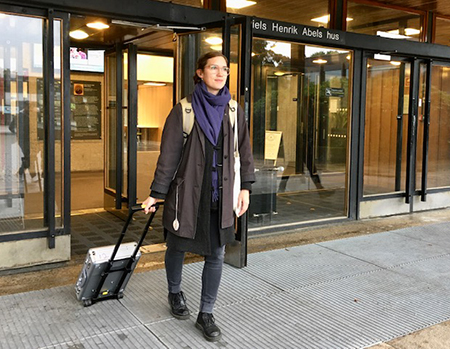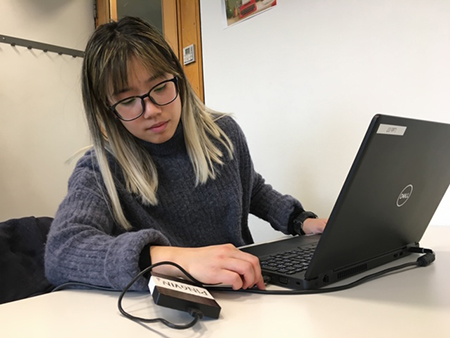In each of the schools participating in the VIST project there are three Norwegian teachers and three mathematics teachers who are video recorded whilst teaching over the span of several lessons. The filming is done by the VIST film team, consisting of research assistants. The resulting video material is the starting point for VIST mentoring and discussions with the teachers. With nine schools participating in the project in Oslo, arranging the filming to take place requires careful coordination. Cecilia You, Celine Simers Iversen and Ruben Bredal are the film team coordinators and shed some light on what goes on behind the scenes to accommodate for the VIST project.
Video to support excellence in teaching (VIST) is an innovative, practice-based professional development effort, where secondary school teachers’ classroom practices are video recorded, analysed and discussed in close collaboration between teachers and the VIST-mentors.
Responsible for collecting video data
The film team coordinators have the overall responsibility for making sure the filmed material and data required for the VIST project is collected. They work directly with the schools and Head Teachers, as well as arranging schedules with the teachers, and collecting consent forms from the students. Once schedules are agreed upon, they make a plan for the filming.
Celine Simers Iversen coordinates the filming in two schools during the semester.
- My main task is to ensure that the research assistants have all that they need – everything from the right information about the classroom and teacher, to making sure all the equipment is available and includes all that they need for the filming, she says.
She is also responsible for the communications between the schools and the Department of Teacher Education and School Research.

Sometimes the coordinators do some filming themselves. This might happen in case a research assistant cannot do it, or due to own interest in filming a specific class, Ruben Bredal says. Cecilia You adds that it is both interesting and educational to do so.
- I feel that I am doing an important job.
Filming the lessons can be an intense process from start to finish, Celine Simers Iversen elucidates. First it is a matter of finding the right classroom and ideally meeting the teacher before rigging the room up for filming. This involves setting up two cameras, one at the front of the class, to film from the teachers perspective, and the other one at the back of the classroom. The room is also fitted with several microphones to capture the discussions that take place. Everything needs to be ready by the time the students arrive.
Once the filming starts, it's possible to lean back and observe.
Possibility to observe classroom teaching
Since research assistants in the film team are in teacher education themselves at the Department of Teacher Education and School Research, they feel they benefit from the opportunity to observe the classroom instruction whilst filming.

Mathematics is one of the subjects Cecilia You will teach one day. Therefore it is especially interesting for her to observe maths teachers and how they are instructing. This gives her new ideas and a possibility to reflect on how she will want to instruct herself.
- Another aspect is that I get to observe many different teachers who all have their different ways to manage the pupils, she says. It is also nice to get a sense of the different environments that can vary from school to school. The pupils create the dynamics in the classroom, she explains.
For Ruben Bredal, to be able to film teachers is an incredibly beneficial and educational experience.
Not only do we get to see some of the best quality instruction, but also as teacher students, we get an opportunity to see teachers in practice. This is very helpful in terms of our own education. In addition to reading theory, we have an opportunity to see that theory applied in practice, he elaborates.
Offers a unique perspective
Filming and observing classroom instruction offers VIST research assistants a unique perspective into what is going on in the classrooms. By being part of the VIST film team they enter the classroom neither as students having to learn themselves, nor as teachers having to deliver instruction.
- We are positioned in a unique place to be able to analyse both teachers and students, and how they influence each other, Ruben Bredal says. We can see how the teachers' instruction methods and techniques affect the pupils, how they perceive them, and whether they result in increased classroom engagement.
- This is absolutely essential for us who will become teachers ourselves. It will make us better prepared once we enter the job market, than if we had not been part of the VIST project.
- It is exciting to observe teachers instructing, Celine Simers Iversen adds, and it is the overall acquired experience one gets when filming a lot that makes this especially interesting. In practice, you usually follow one teacher for a certain period, but as a research assistant in VIST, you get to visit many different classes, schools and teachers.
- I get inspired by teachers, and am motivated to participate in something similar myself once I am a teacher. They are brave. At the same time, I can really see the benefit of allowing competent experts to observe one’s practice, Iversen says.
Visiting so many different schools also introduces the research assistants to possible future working environments.
- I like to feel the atmosphere in the different schools, Iversen says. And then I wonder, is this perhaps my future workplace?
